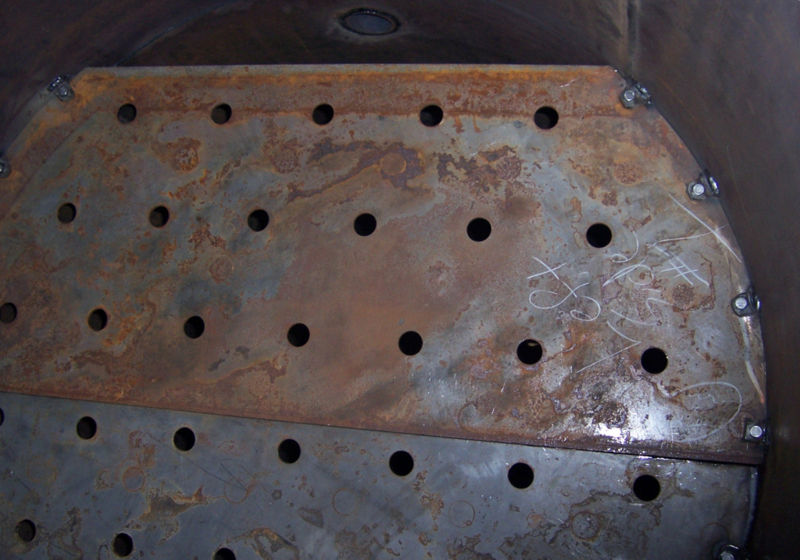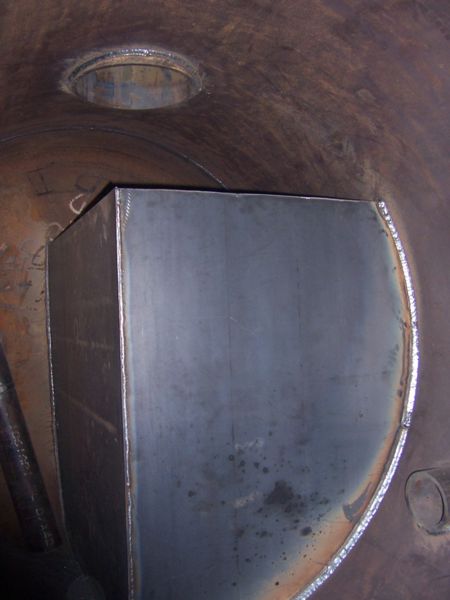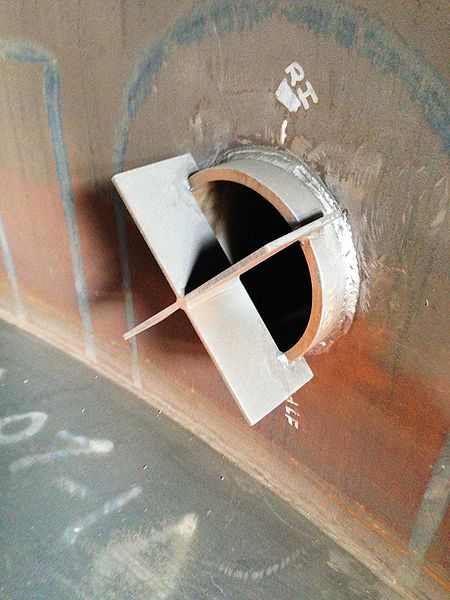Free Water Knockout
Free water knockout, abbreviated as FWKO, is a pressure vessel that uses residence time to separate water from the production process. It is usually the first part of an oil dehydration facility. Removing unwanted water in the process stream can reduce processing steps by reducing the size of downstream equipment and lowers energy requirements. Water leaving the FWKO is further processed to remove contaminants and then may be used for injection, boiler feed water or for sale. Oil and emulsion is processed further until the oil is ready for sale.
 Free Water Knock Out Schematic
Free Water Knock Out Schematic
Because the FWKO is usually the first piece of processing equipment after the oil well, it can collect solids that come up with the oil and water. For very sandy wells, the FWKO can be automatically cleaning by pushing water through a series of nozzles at the bottom of the vessel to move sand that may have collected. Some free water knock outs operate as a three phase (oil, water, gas) or as a fluid packed two phase (oil, water) vessel.
A FWKO works best when the process is as stable as possible. Large swings oil or water may cause the process to upset. To assist in separation, the incoming production stream might be preheated prior to the FWKO. This is usually with a shell and tube heat exchanger utilizing heat that would otherwise have been wasted.
The free water knock works based on speed that the oily emulsion will separate from the water. This speed depends on many things like the difference in specific gravities, the temperature and the viscosity between the fluids. A low residence time is as short three to five minutes for light oil. Heavy oil can have residence times as long as 30 minutes. If it is a tight emulsion, chemicals may be introduced to the FWKO to help break the emulsion.
Free Water Knockout Advantages and Disadvantages | |
|---|---|
| Advantages | Disadvantages |
|
|
Nozzle Types Used
Production Inlet - This will be the largest nozzle because it contains the entire process.
Oil & Emulsion Outlet
Water Outlet
Gas Outlet - If operating as a three phase vessel or if the vessel is on a vapor recovery system.
Sand Cleanout - Series of nozzles at the bottom of the FWKO that direct water into predetermined locations of the vessel to clean the sand from the bottom of the vessel.
Pressure relief valve - Should be sized based on the design code the vessel is designed to
Manway - If there are multiple baffles, ensure there is access for an inspector.
Nozzles for control devices - High level, low level, interface, pressure and temperature.
Sample Box - A container or kit used in the oil and gas industry to collect, store, and transport samples of oil, gas, water, or other substances.
Free Water Knockout Typical Internals
- Inlet Deflector or Baffle - Reduces disturbance from the inlet fluids and keeps them from creating a channel through the FWKO.
- Calming Baffle/ Wave Beaker - If you’re using that experiences surges, a baffle will help dampen inlet surges.
- Weir Box - A weir box may be used to separate ensure that the oil/ emulsion outlet does not get contaminated with water.
- Vortex Breaker - Discharge nozzle to prevent the discharge from drawing from the gas blanket.
- Jets - Jets to direct flow rate to help clean out sand.
 Wave breaker or calming baffle
Wave breaker or calming baffle Oil wier in a vessel
Oil wier in a vessel Vortex breaker in a tank
Vortex breaker in a tank
Free Water Knockout Design Considerations
- When sizing a FWKO, size it for the highest reasonable expected flow rate. As the rates decrease, residence time increases the efficiency of the unit.
- For gassy services, consider using the FWKO as a three phase vessel. Entrained gas carried through the water or oil outlet will cause flow meters to show an erroneous flow rate. If the production stream is gassy, running the separator at higher pressures will keep the gas from breaking the gas out of the fluid.
- As with all pressure vessels, it is easier (and cheaper) to add extra nozzles during the initial fabrication than it is after the vessel has been in operation.
- If pumping is needed upstream of the FWKO, a low shear pump, such as a progressing cavity pump should be used. A centrifugal pump (high shear) will cause the emulsion to tighten which will increase the amount of time needed to separate the oil and water.


